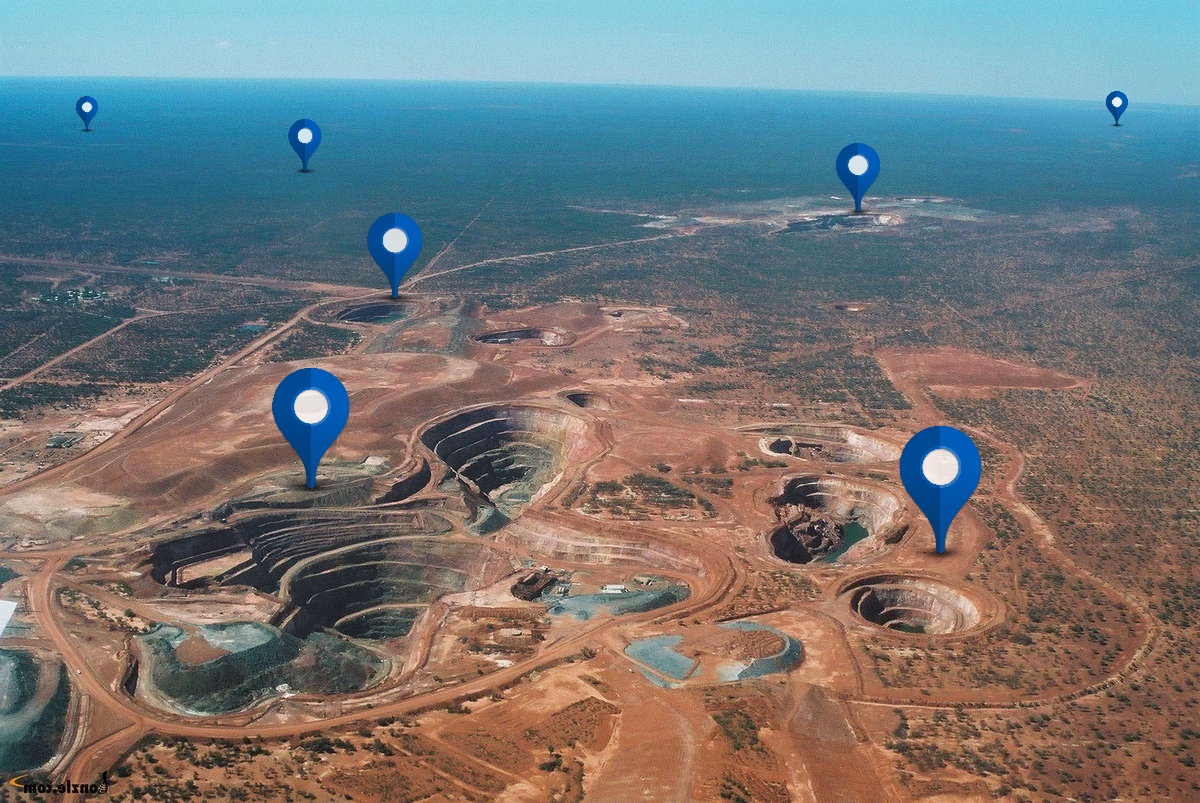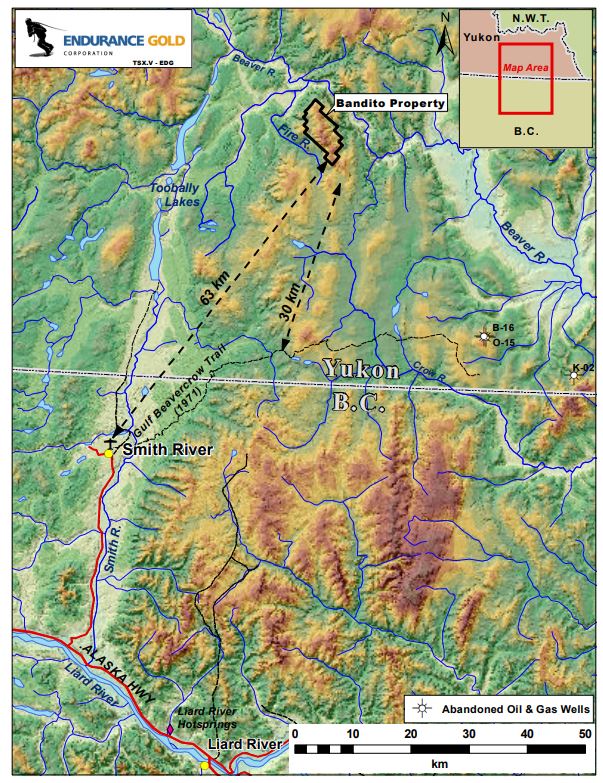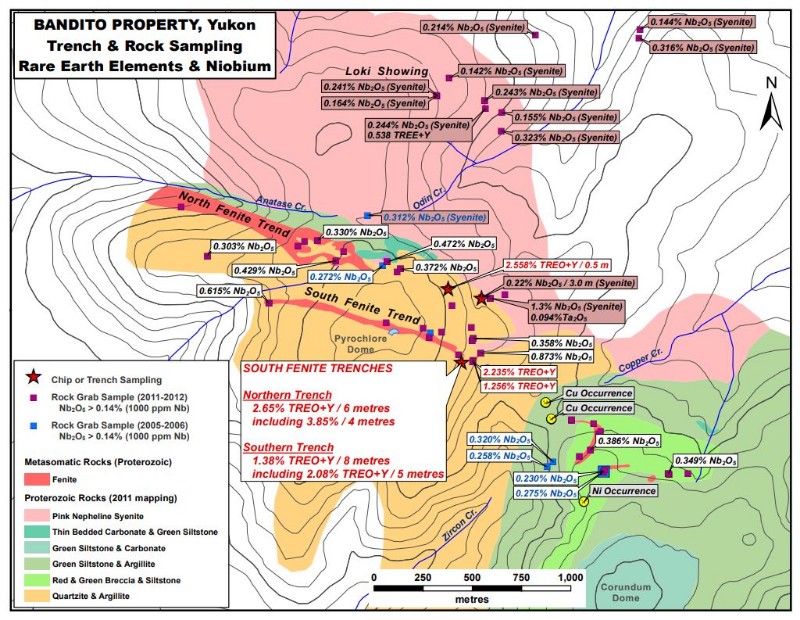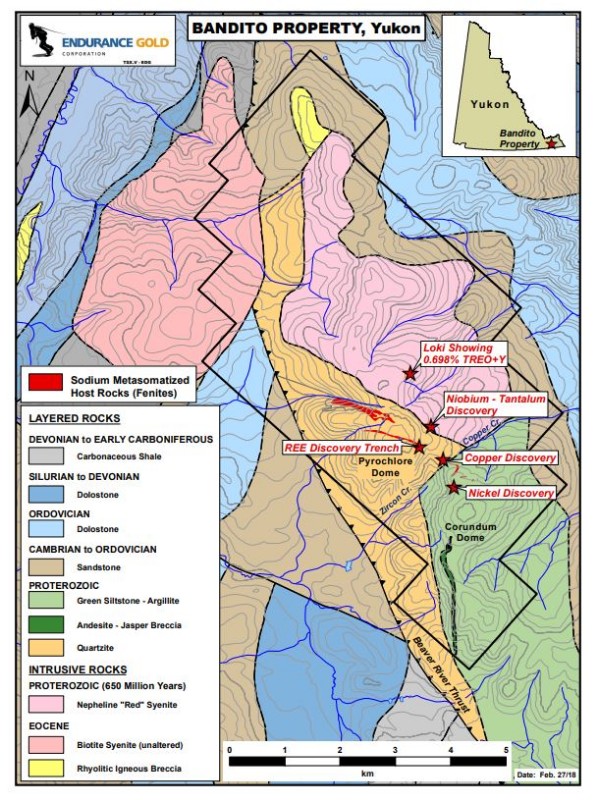Do you need a financi Read more [...]
Bandito Niobium-Rare Earth Project (Yukon)
Project Category: Exploration
-
OVERVIEW:
The Bandito property is 3,700 hectares in size and located in the southeastern Yukon, 155 kilometres east of Watson Lake, and 63 kilometres northeast of the road head and air strip located at Smith Falls, British Columbia. A trail that accessed historic petroleum drilling activity in the southeast Yukon passes within 30 kilometres of the property. The Liard Basin, an emerging shale gas basin is located south east of the property. The moderate relief terrane is largely tree-covered with bare ridge tops.The Bandito Property is 100% owned by Endurance Gold Corporation (“Endurance”) and was originally optioned in 2010 and then subsequently purchased in 2013. The original vendor retains a 1% Net Smelter Returns Royalty (“NSR”). Endurance can purchase ½ of the NSR at any time for $1 million.
GEOLOGY HIGHLIGHTS:
The Bandito property is underlain by a thrust window of mid-Proterozoic-aged argillite, quartzite and stratabound polymictic breccia which have been intruded by an eleven (11) square kilometre Late Proterozoic-aged (650 Ma) multi-phased reddish coloured nepheline syenite with pegmatitic, fine and coarse grained phases mapped as the Pool Creek Syenite (“Red Syenite”). An approximate nine (9) square kilometre area of the Red Syenite has been observed to be metasomatically altered with pervasive hematization causing the characteristic red colouration.Numerous niobium, rare earth, nickel, copper and zirconium prospects have been identified over the nine (9) square kilometre altered area with values up to 3.491% Total Rare Earth Oxides plus Yttrium (TREO+Y), 1.3% Nb2O5, 11.35% nickel, 1.76% copper, and 1,125 ppm cobalt.
90th percentile anomalies-in-soil for Rare Earth Elements (REE) plus yttrium (+496 ppm), zirconium (+576 ppm), niobium (+146 ppm), and thorium (+28 ppm) are kilometres in scale indicating undiscovered potential for an intrusive-hosted rare earth-niobium enriched mineralizing system with significant size potential. The nickel, copper and cobalt prospects are associated with 90th percentile anomalies-in-soil for copper (+54 ppm), nickel (+30 ppm) and arsenic (+25 ppm) that are geographically distinct from the REE-zirconium-niobium soil anomalies.
ALTERATION & MINERALISATION:
Alteration occurs both within the Red Syenite, and in the adjoining mid-Proterozoic-aged sediments. Alteration in the Red Syenite is a result of potassium and sodium metasomatism and the introduction of fluorite, hematite and rare earth elements. Petrographic examination indicates replacement of nepheline by sericite and replacement of Na-amphibole and aegirine by albite, quartz, chlorite, biotite, fluorite, hydrothermal zircon, and Fe-oxide minerals. In the Red Syenite magmatic pyrochlore has been in places pseudomorphed by Fe-columbite and elsewhere altered and the niobium remobilized into ilmenorutile, nioboaeschynite, and Fe-columbite replacing sodic mafic minerals in the syenite.Alteration of the Proterozoic clastic host rocks involves extensive hornfels and more localized kilometre-scale zones of fenitization involving alteration and replacement by potassium feldspar, albite, carbonates, arfvedsonite, riebeckite, aegirine, magnetite, specular hematite, chlorite, rhodonite, sphene, zircon, monazite, apatite, xenotime, pyrochlore, fluorite, and apatite (Fenite).
Where observed to date, the REE mineralization is entirely secondary in nature in the form of REE-flourocarbonates and REE-phosphates. Synchysite, bastnaesite, parasite, monazite and cheralite are the REE minerals identified to date. Primary magmatic REE minerals have not yet been observed but may exist as a pre-cursor magmatic phase in the Red Syenite.
Petrographic studies have concluded that there is a high temperature alteration of high field strength elements and subsequent transport of these elements with fluorine and phosphate complexes. The deposition and concentration has resulted in metasomatic replacement rocks both within the Red Syenite and the Fenites.
Separately, a quartz-sericite-pyrite stock work alteration zone (“QSP Alteration”) is associated with the nickel and copper prospects. This QSP Alteration has different characteristics from the sodium metasomatism in the REE-Nb system and may represent an unrelated alteration event that in part overlaps the Fenite alteration.
EXPLORATION HISTORY (1975 > 2014)
The Bandito property was explored from the mid 1970’s through 2014 for thorium-uranium, copper, nickel and rare earth elements (REE), with encouraging results for Niobium and REE in multiple samples over the nine square kilometre altered area associated with the Red Syenite and Fenite. Exploration and evaluation work was completed by the following companies:
> 1970’s – Eldorado Nuclear — airborne radiometric survey
> 1977 – Silver Standard Mines — prospecting for thorium and uranium
> 1980 – E&B Explorations Ltd. option — thorium-uranium-rare earth exploration
> 1980 to 1987 – Silver Standard Mines Ltd — rare earth exploration
> 1987 – Unocal Canada and Molycorp — rare earth acquisition evaluation
> 2004 to 2006 – True North Gems Inc — nickel exploration, gemstone reconnaissance
> 2010 to 2014 – Endurance Gold Corporation — niobium, rare earth exploration in metasomatized syenite/fenite and copper nickel exploration in the QSP alteration zone. Endurance has expended about C$810,000 in exploration expenditures on the Bandito Project since acquisition in 2010.LATEST EXPLORATION RESULTS (2010 – 2014) – REE & Niobium/Tantalium
The highlights of Endurance’s rock sampling programs are summarized below. A compilation summary report for the property has been completed, as well as subsequent petrographic study targeted on the Red Syenite.Trench and rock sample results for niobium and rare earth are illustrated and summarized on the REE-Niobium summary map.
Rare Earth Highlights — The most significant prospects sampled in the Red Syenite resulted from follow-up prospecting of a large REE-Niobium syenite-hosted soil anomaly. Highlights of this bedrock grab and float samples include:
> highly metasomatized syenite – 3.491% TREO+Y with 76.7% HREO ratio, 0.887% Nb2O5, 43.2% ZrO2.
> highly metasomatized syenite — 1.978% TREO+Y with 74.9% HREO ratio, 0.958% Nb2O5, 43.6% ZrO2.
> hematite altered syenite — 0.698% TREO+Y with 46% HREO ratio.
Note: TREO+Y is the addition of all converted oxide percentage values for the complete suite of rare earth elements plus yittrium. HREO ratio refers to the percentage of the heavy rare earth oxides (from europium to lutetium plus yttrium) as a percentage of all rare earth oxides.The most significant prospects sampled in 2011 include two highlight trenches on the South Fenite Trend which returned the following results:
South Fenite Trenches
> Northern 2.65% TREO+Y Over 6 metres
Including 3.85% TREO+Y Over 4 metres
> Southern 1.38% TREO+Y Over 8 metres
Including 2.08% TREO+Y Over 5 metres
The South Fenite trench (northern) averages 10.3% heavy rare earth oxides (HREO) of which 9.8% is neodymium oxide (Nd2O3).Niobium & Tantalum Results Highlights – In the Red Syenite, rock sampling has identified several significant niobium-tantalum prospects including one grab sample which contained 1.3% Nb2O5 (9100 ppm Nb), and 0.094% Ta2O5 (768 ppm Ta). Other grab samples in syenite returned 0.958% Nb2O5, 0.323% Nb2O5 (grab), and 0.316% Nb2O5 (grab), 0.312% Nb2O5 (grab), and 0.243% Nb2O5 (grab). Other peak values in the Red Syenite include chip samples of 0.22% Nb2O5 over 3.0 metres, and 0.22% Nb2O5 over 3.0 metres.
The elevated niobium values in syenite are contained within a two (2) square kilometre area underlain by metasomatized syenite that is largely tree covered with poor outcrop exposures.
In the North Fenite, South Fenite and Copper Pass Fenite (2.9 kilometres strike) about thirty (30) samples returned values greater than 1000 ppm niobium (>0.143% Nb2O5) including values up to 0.429% Nb2O5 over 1.0 metre and 0.21% Nb2O5 over 6 metres.
LARGE REE & NIO-TANTALUM SOIL ANOMALIES
Highlights of results from soil sampling of 1464 samples 100-metre spaced sampling includes the recognition of:
> An approximate 1.4 kilometre long by up to 600 metre wide syenite-hosted niobium-tantalum soil anomaly. Niobium Tantalum Soil Map
> An approximate 1.8 kilometre long by up to 400 metre wide syenite-hosted rare earth soil anomaly. Rare Earth Element Soil Map
The strongest of the 90th percentile niobium-tantalum and rare earth soil anomalies are underlain by Red Syenite and extend to the edge of the sampled grid indicating potential to expand the target area with additional soil sampling.NICKEL – COPPER EXPLORATION RESULTS
All of the copper and nickel prospects are associated the QSP Alteration which expresses as a large gossan due to the weathering of pyrite (“Gossan Target”). Rock sample results for copper and nickel are shown on the copper-nickel summary map.Nickel Discovery Zone – Grab samples from the Nickel Discovery Zone assay up to 11.35% nickel, and 1125 ppm cobalt. Endurance collected representative samples from six prospect pits over a thirteen (13) metre width. These pits average 0.8% nickel, 794 ppm copper and 61.5 ppm cobalt. The pits are distributed evenly across 13 metres of QSP Alteration and secondary nickel bloom.
Six Copper Prospects – In addition to the Nickel Discovery Zone, six other copper and copper-nickel showings have been identified and sampled extending the area of known nickel and copper prospects to 580 metres by 200 metres in the Gossan Target. All of the copper showings are coincident with the QSP Alteration. Two of the copper showings were systematically chip sampled from trenches with the following results:
Gossan Target – Copper Pass Area – Copper Trenches
Eastern 1294 ppm Copper, 974 ppm Zinc
0.21% Nb2O5, 0.28% TREO+Y Over 6 metres
Western 1251 ppm Copper and 993 ppm Nickel Over 5 metres
In the eastern trench, the QSP alteration overlaps the potassium metasomatic alteration (Fenite).
The strongest of the 90th percentile copper and nickel soil anomalies are underlain by Proterozoic sediments and, in part the Fenite and associated with the known copper and nickel prospects. The anomalous soils are primarily associated with the Gossan Target encompassing an area of about 600 metres by up to 600 metres. In addition, two other nickel-copper soil anomalies have been identified in soil sampling but not yet prospected. See the Nickel Soil Map and Copper Soil Map.PERMITS & CSR
The Bandito Project falls within the traditional territories of the Liard First Nation. A Yukon Class 3 YESAB permit that allowed for drilling and trenching was successfully acquired for Bandito. This YESAB permit has expired and a new application will need to be completed to conduct drilling activities. Soil sampling, prospecting, hand trenching and airborne activities can be conducted under either a YESAB Class 1 or Class 2 permit.RECOMMENDED EXPLORATION
Additional exploration is warranted on the Bandito property. Due to the large geochemical footprint, particular attention should be given to the possibility of bulk tonnage rare metal (Rare Earth Elements – Niobium – Tantalum – Zirconium – Hafnium) targets hosted within the Red Syenite. Further recommended exploration includes:Complete an airborne vertical and horizontal gradient magnetics and radiometrics geophysical survey to encompass the entire known area of the Red Syenite and Fenite and to cover areas of regional magnetic anomalism similar to the target area.
Complete a lidar airborne (UAV) survey to identify potential zoning features in the Red Syenite.
Broad based soil sampling (at100 metre grid spacing) to encompass the entire (11) eleven square kilometre area of the Red Syenite as well as the unsampled western extensions of the Fenites.
In areas of current elevated rare metals in soils, and those identified with additional sampling, tighten up the soil sample spacing to better define areas for trenching and diamond drill testing.
Field based XRF supported and regional rock sampling programs within the Red Syenite and Fenite.
Ground based GPS-enabled scintillometer survey coincident with the soil grid or to evaluate any airborne radiometric targets.
Trenching and systematic chip sampling of Red Syenite targets.
Drilling is warranted on the Red Syenite, Fenite, and nickel targets.
Further petrographic scanning electron microscope (SEM) and geochronology studies on the extensive reference collection of samples from the 2010 to 2014 exploration activities to identify rare metal mineralogy and potential controls for mineralization.Robert T. Boyd, P.Geo. is a qualified person as defined in National Instrument 43-101 and supervised the compilation of the information forming the basis for this summary.
-
Total Resource Estimate (M+I+I): None
-
-
Key Documents: Bandito-Executive-Summary-Feb-2018.pdf



